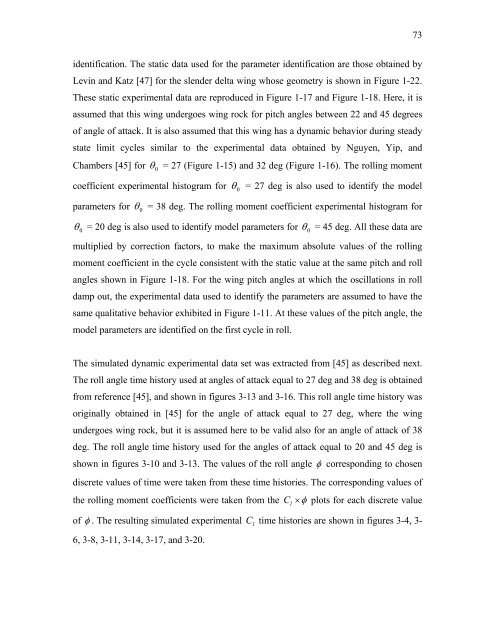Aircraft Stability Analysis Including Unsteady Aerodynamic Effects
Aircraft Stability Analysis Including Unsteady Aerodynamic Effects
Aircraft Stability Analysis Including Unsteady Aerodynamic Effects
You also want an ePaper? Increase the reach of your titles
YUMPU automatically turns print PDFs into web optimized ePapers that Google loves.
73identification. The static data used for the parameter identification are those obtained byLevin and Katz [47] for the slender delta wing whose geometry is shown in Figure 1-22.These static experimental data are reproduced in Figure 1-17 and Figure 1-18. Here, it isassumed that this wing undergoes wing rock for pitch angles between 22 and 45 degreesof angle of attack. It is also assumed that this wing has a dynamic behavior during steadystate limit cycles similar to the experimental data obtained by Nguyen, Yip, andChambers [45] for θ0= 27 (Figure 1-15) and 32 deg (Figure 1-16). The rolling momentcoefficient experimental histogram for θ 0= 27 deg is also used to identify the modelparameters for θ0= 38 deg. The rolling moment coefficient experimental histogram forθ0= 20 deg is also used to identify model parameters for θ0= 45 deg. All these data aremultiplied by correction factors, to make the maximum absolute values of the rollingmoment coefficient in the cycle consistent with the static value at the same pitch and rollangles shown in Figure 1-18. For the wing pitch angles at which the oscillations in rolldamp out, the experimental data used to identify the parameters are assumed to have thesame qualitative behavior exhibited in Figure 1-11. At these values of the pitch angle, themodel parameters are identified on the first cycle in roll.The simulated dynamic experimental data set was extracted from [45] as described next.The roll angle time history used at angles of attack equal to 27 deg and 38 deg is obtainedfrom reference [45], and shown in figures 3-13 and 3-16. This roll angle time history wasoriginally obtained in [45] for the angle of attack equal to 27 deg, where the wingundergoes wing rock, but it is assumed here to be valid also for an angle of attack of 38deg. The roll angle time history used for the angles of attack equal to 20 and 45 deg isshown in figures 3-10 and 3-13. The values of the roll angle φ corresponding to chosendiscrete values of time were taken from these time histories. The corresponding values ofthe rolling moment coefficients were taken from theC × φ plots for each discrete valueof φ . The resulting simulated experimental time histories are shown in figures 3-4, 3-6, 3-8, 3-11, 3-14, 3-17, and 3-20.C ll
















